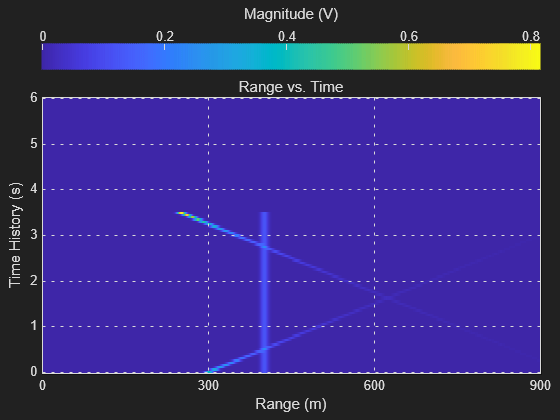phased.RTIScope
Range intensity scope
Description
The phased.RTIScope
System object™ creates a scrolling display of range response intensity as a function of time.
Each row represents the range response for a pulse or FMCW signal. Sequential calls to the
object add new rows to the bottom of the display window. Columns represent the responses at a
specific range over all pulses. You can input two types of data - in-phase and quadrature
(I/Q) data or response data.
I/Q data – The input consists of fast-time I/Q samples for one or more pulses or FM sweeps. The scope computes the range response and adds it to the display. To use I/Q data, set the
IQDataInputproperty totrue. In this mode, you can set the properties shown in Properties Applicable to I/Q Data.Response data – The data consists of the range response itself. The scope adds the range response to the display. For example, you can obtain the range response from a
phased.RangeResponseobject. To use response data, set theIQDataInputproperty tofalse. In this mode, you can set the properties shown in Properties Applicable to Response Data.

To create and run a range-time intensity scope,
Create the
phased.RTIScopeobject and set its properties.Call the object with arguments, as if it were a function.
To learn more about how System objects work, see What Are System Objects?
Creation
Description
scope = phased.RTIScopescope. This object displays the intensity of the
range-time response for the input data.
scope = phased.phased.RTIScope(Name,Value)scope, with each specified
property set to the specified value. You can specify additional name-value pair arguments
in any order as
(Name1,Value1,...,NameN,ValueN).
Enclose property names in quotes. For
example,
scope = phased.RTIScope('IQDataInput',true,'RangeMethod', ...
'FFT','SampleRate',1e6,'TimeResolution',0.5,'TimeSpan',10.0, ...
'RangeFFTLength',1024);Properties
Usage
Syntax
Description
scope(X)X can be I/Q
sample data or range response data depending on the value of the
IQDataInput property.
scope(X,Xref)X. This syntax applies when you set the
IQDataInput property to true, the
RangeMethod property to 'FFT', and the
DechirpInput property to true. This syntax is
most commonly used with FMCW signals. Xref is generally the
transmitted signal.
scope(X,coeff)coeff. This syntax
applies when you set the IQDataInput property to
true and the RangeMethod property to
'Matched Filter'. This syntax is most commonly used with pulsed
signals.
Input Arguments
Object Functions
To use an object function, specify the
System object as the first input argument. For
example, to release system resources of a System object named obj, use
this syntax:
release(obj)
Examples
More About
Version History
Introduced in R2019a

